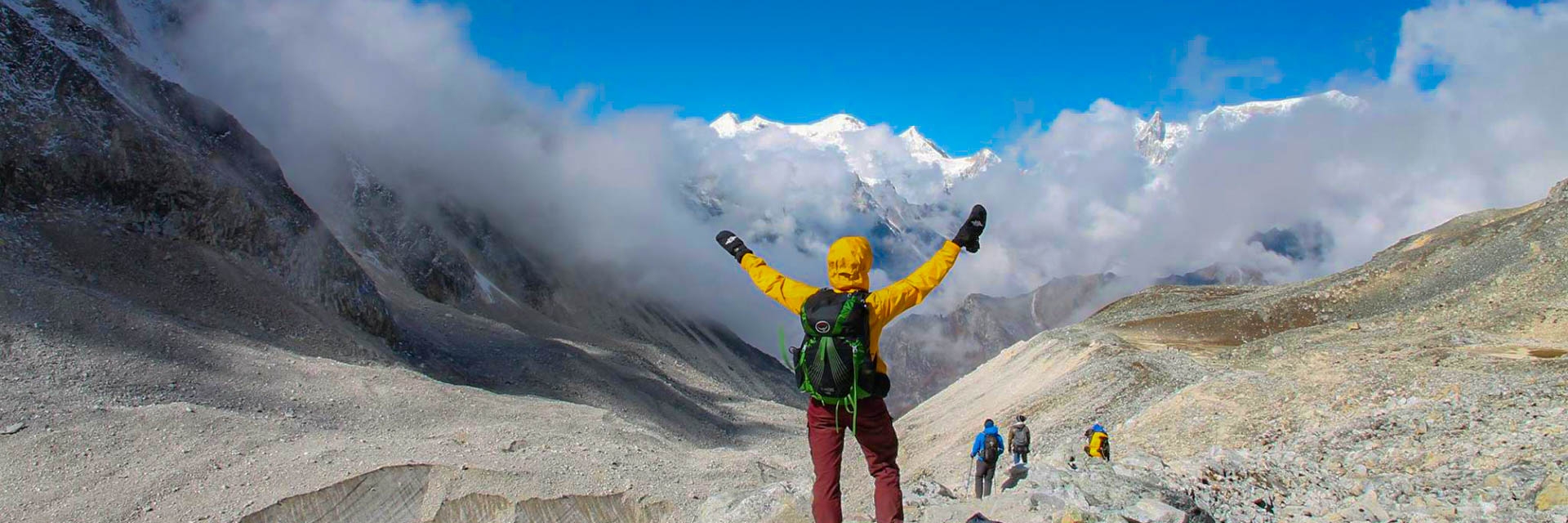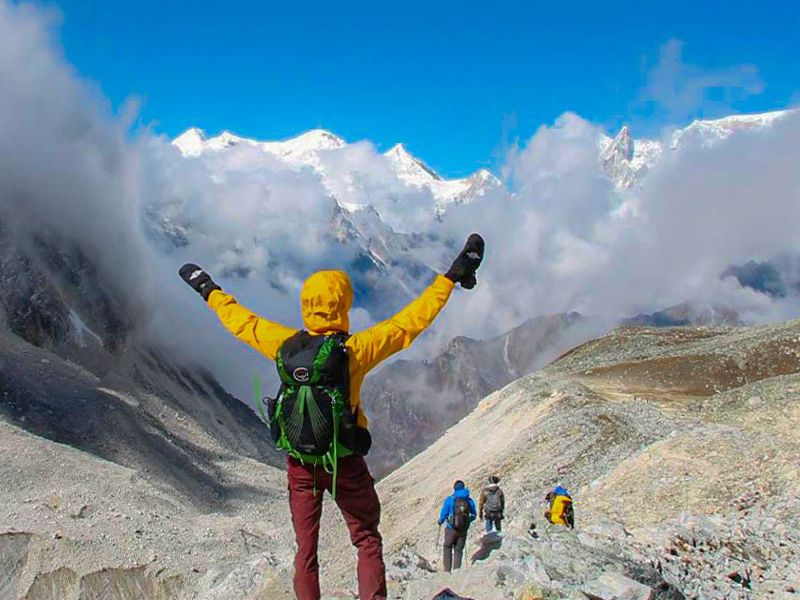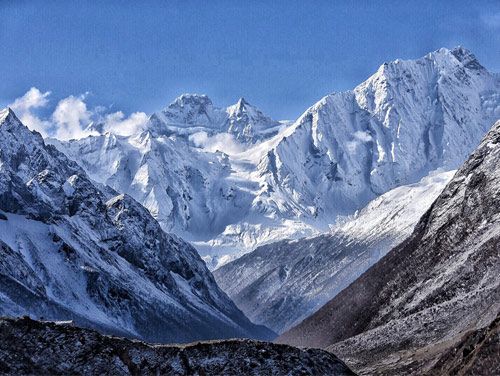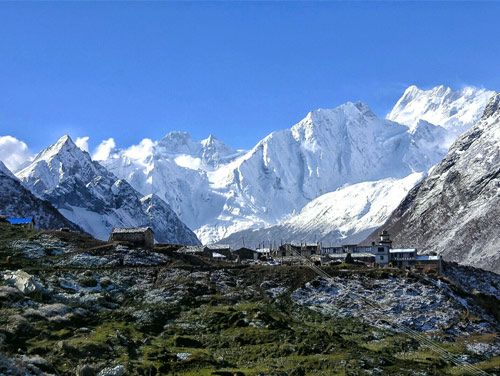Accommodation in Manaslu Circuit Trek
The accommodation on the Manaslu Circuit Trek is simple and comfortable. You'll stay in tea houses along the way, which offer clean rooms with basic amenities like a bed and a blanket. Some tea houses provide hot showers for an extra cost.
The rooms are basic in Manaslu Trek, but they provide a warm space to recover from a day of hiking. The cuisine is largely local (e.g., dal bhat, noodles, soup). Though the facilities are basic, the warm hospitality of the local people makes the experience more enjoyable and welcoming.
Food during Manaslu Trekking
The food on the Manaslu Circuit Trek is basic but gratifying. Dishes such as dal bhat (lentil with rice soup), noodles, soup, and vegetable curries will be most common. Tea houses provide a variety of meals, such as Tibetan bread, momo (dumplings) and porridge to start the day. The food options may be fewer and fewer, but the meals are still satiating and balanced. Food is cooked fresh, and it is a cozy comfort to enjoy a hot meal after completing a long trek. Drinking enough water and tea is also useful for staying hydrated during the trip.
Manaslu Circuit Trek Permits
To trek the Manaslu Circuit, you need several permits.
The first is the Manaslu Conservation Area Permit (MCAP), which allows you to enter the conservation area and helps protect the local environment.
The second is a permit for the Annapurna Conservation Area (ACAP) since the route has portions within the Annapurna region. Both permits can be obtained very easily with the help of a trekking agency, The Himalayan Odyssey.
A Special Restricted Area Permit (Manaslu RAP) is the most crucial permit for Manaslu Trek. This permit is required because the Manaslu Circuit is a protected territory. There are only relatively few hikers allowed to ascend the mountain each year. This permit can only be obtained by a registered trekking agency and is provided under the number of people in your group. Each of these permits guarantees a safe and regulated walk in the Manaslu area.
Travel Insurance
Travel insurance is very important for the Manaslu Circuit Trek to cover you against unfortunate events. It should include emergency evacuation, medical costs, trip rescheduling, and lost items. Because the trek is high altitude, there must be insurance to cover altitude sickness, such as acute mountain sickness (AMS).
Speaking of trekking activities, coverage for trekking is also a necessity, particularly if you intend to go over the Larke La Pass or travel into the wilder regions. Emergency evacuation by helicopter may be costly, so confirm that your insurance will cover this procedure.
Do note that before buying, ensure that the insurance satisfies all the needed trekking requirements in Nepal. It is recommended to get travel insurance that covers all possible risks to ensure peace of mind during your trek.
Best Seasons for Manaslu Circuit Trek
The best time for Manaslu Circuit Trek is spring (March to May) and autumn (September to November). It is a clear and stable weather month, and the mountains and pastoral scenery are very good conditions. Spring is marked by temperate weather and flowers in bloom, while autumn is during cool air and blue days.
It is a good trekking season because the trails are dry, so it is comfortable to walk. Winter (December to February) can be too cold with heavy snow, and summer (June to August) is rainy, making it harder to trek. Spring and autumn are, therefore, the ideal seasons to go.
Manaslu Trek Weather
Manaslu Circuit weather conditions depend on altitude and season. In spring (March to May) and autumn (September to November), the weather is generally clear and mild. Temperatures vary from 10°C to 15°C in the day but can fall below freezing overnight, particularly at higher levels. Its weather is perfect for hiking with clear sky and great visibility.
In winter (December to February), it gets very cold, especially above 3,000 meters. Snowfall is frequent, and temperatures can go below 0°C.
During the summer monsoon season (June to August), the weather is rainy and wet, making trekking difficult. Trails can become slippery, and landslides are a risk. Trekking is not advisable during monsoon season due to safety and comfort reasons.
Manaslu Circuit Trek Map
A map of the Manaslu Circuit Trek is needed and as a backup option for navigation should be kept in the bag. It facilitates a good orientation on the right path and a deeper understanding of its way.
Although your guide helps you, there is much reassurance that comes from a map. It is also possible to use the map to look around and see exactly where the trek is at. The following is a copy of a screenshot of the map that you can download for use during the trial.
Manaslu Circuit Trek Distance
The Manaslu Circuit Trek is around 177 kilometres (110 miles) in length. The trek usually takes about 14 to 16 days to complete, depending on the pace and itinerary.
The route takes you through various villages, forests, and high-altitude areas, offering stunning views of Mount Manaslu and the surrounding mountains. Each day's hike ranges from 5 to 10 kilometres, with some days requiring more effort due to higher elevations.
Distances and field topography may differ, and to help reduce altitude, one would have to take it easy and allow enough time for acclimatization.
Challenging and Safety Tips
The Manaslu Circuit Trek is a demanding trek because of the altitude, long trekking hours, and the difficult terrain. To be safe, acclimatization must be done well, by using days off and slow walking to guide your body acclimatization to the altitude.
The hydration of the body is also very crucial; therefore, it is of utmost value to take a large amount of water during the trek. Wear multiple layers to keep warm and dry, as the weather may be unpredictable.
Hiring a professional guide can make the hike safer because they will be able to lead the way along the trail and can also be made to help with any trouble that presents itself. Never stop taking care of your body; if you feel sick, stay at home and consult a doctor if necessary. Bring only the necessities and thereby avoid unnecessary burdens.
Adhere to protective measures by staying on properly marked trails and mitigating dangerous detours. By adhering to the following safety recommendations, you can guarantee a safe and enjoyable trekking experience.
Fitness and Acclimatization
Fitness and acclimatization are significant features of the Manaslu Circuit Trek. To prepare, focus on building endurance with regular hikes, cardio exercises, and strength training. Go for long walks and steep hill climbs to prepare your body for the demands of the trek.
Acclimatization is crucial to avoid altitude sickness. The trek goes to great heights, and it's to be done very slowly, especially on days of high-altitude gain. Don't forget to include rest days in the trek so your body can acclimatize.
Stay hydrated and eat well to maintain energy. If you experience any signs/symptoms of altitude sickness such as headache/vertigo, don't dismiss them. Descend to a lower altitude and rest until you feel better.
Currency exchange
Currency exchange is an important part of planning your trek. The local currency of Nepal is the Nepalese Rupee (NPR), which is used for all activities along the trek.
Money can be exchanged at banks, licensed money exchange offices, or in important cities such as Kathmandu.
It's best to carry some cash, as ATMs are not available in remote areas like the Manaslu Circuit.
Keep smaller denominations for tea houses and small purchases. Confirm the exchange rates at least before departure to get the optimal exchange rate.
Emergency Preparedness
Emergency preparedness is highly necessary in Manaslu Circuit Trek. Always travel with a professional guide with a knowledge of the route and of the safety aspects.
Carry a first aid kit with basic medicines for altitude sickness, headaches, and stomach issues. Ensure that you have travel insurance with high altitude trekking and helicopter rescue coverage.
You should let your guide know if you become ill on the hike. Drink a lot of fluids and acclimatize adequately to prevent altitude sickness. Collect emergency contact details and maintain a fully charged mobile phone for communication.
The Himalayan Odyssey is safe due to the use of experienced guides and contingency plans. Maintaining vigilance and attention to guidance will allow you to cope with any unplanned events during the trek.
Porter service in Manaslu circuit trek
The Porter service is there to assist travellers on the Manaslu Circuit Trek journey. Porters take your load, enabling you to hike with a daypack on your back.
They usually have loads up to 20-25 kg, that are distributed between two hikers. Hiring a porter not only reduces your physical strain but also supports local employment.
Porters know the path well and can help in a basic way if it is required. Nevertheless, it is essential to bring only necessary things and be considerate of their restrictions.
The Himalayan Odyssey ensures reliable and well-treated porters for your trek, ensuring both your comfort and their welfare.
Safe Drinking Water in Manaslu Circuit Trek
Safe drinking water is crucial on the Manaslu Circuit Trek. It is possible to replenish water bottles at teahouses or buy bottled water in villages.
Boiled water is supplied at most teahouses and is a suitable choice.
To cut costs and lower plastic waste, keep a reusable water bottle and purification tablets (or a filtration system).
Streams and tap water are found at the edges of the trail and must be purified before consumption. Never forget to bring enough water to drink, particularly at great elevations.
Do not drink bottled water alone to reduce environmental pollution. Keeping cool and hydrated by drinking clean water will allow you to have a healthy and comfortable hike.
Altitude sickness in Manaslu Circuit trek
Altitude sickness is prevalent during high-altitude treks like the Manaslu Circuit Trek. It occurs when the body has difficulty readjusting to a low oxygen supply.
Symptoms include headache, nausea, dizziness, and fatigue. It is common, above 2500m and tends to become worse with altitude.
Drink plenty of water and avoid alcohol or smoking. Eating light and nutritious meals also helps. Listen to your guide's advice and watch for symptoms. If you feel unwell, inform your guide immediately.
If symptoms continue, rest at the same altitude or descend to a lower elevation.
Severe cases may need medical attention or evacuation. Employing experienced guides and good planning is a must.
First aid kit in Manaslu circuit trek
A first aid kit is a must for Manaslu Circuit Trek. It is to be fitted with bandages, antiseptic wipes and adhesive tape for minor injuries. Pack pain relievers, altitude sickness medicine, and diarrhea medication.
To protect your feet when extended walking, insert blister pads. Carry basic items like scissors, tweezers, and safety pins. Include rehydration salts and energy tablets for extra care.
A thermometer and a pocket reference guide on first aid are useful. Your guide will also come with a simple kit; however, it is best to carry your own.
Nepal visa information
For trekking the Manaslu Circuit or touring Nepal, you will require a visa. The visa on arrival is available at Kathmandu's Tribhuvan International Airport as well as the land border crossing points.
You'll need a valid passport with at least six months of validity and a recent passport-sized photo. Tourist visas are for 15, 30 or 90 days. The fee varies based on the duration.
Visa may also be applied to be at Nepalese embassies and consulates even before the journeys. Multiple-entry visas are provided for those who intend to exit and re-enter Nepal. Make sure to carry cash (USD or other accepted currencies) for visa fees.
Extensions can be arranged in Kathmandu or Pokhara if you require to stay for a period. The Himalayan Odyssey can help with the visa process to settle your trip.
Group size for Manaslu circuit trek
The ideal group size for the Manaslu Circuit Trek is usually between 2 to 12 people. There is greater flexibility and individualization when there are smaller groups.
With a group of around 4 to 6 people, it's easier to manage the pace and get the most out of the trek.
Larger groups may be less flexible but also cost-effective and more sociable. It must be noted that the hike requires an issue-specific restricted area authorization, and this may be issued only for groups of a minimum of two individuals.
A guide is also mandatory for safety navigation.
Environmental impacts and reasonable trek
The Manaslu Circuit Trek has certain environmental footprints caused by the larger volume of foot travel, garbage, and load on the community resources.
With increased trekking, the natural environment may be degraded by erosion, garbage, and deforestation. The trekking industry also puts pressure on water sources and energy, especially in remote areas.
To mitigate those effects, sustainable practices are needed. This includes the use of refillable water bottles, not littering and the adherence to marked trails.
Also, utilizing eco-friendly products and patronizing local companies with environmental consciousness can also play a role.
Responsible trekking involves respecting both the natural environment and the local inhabitants. When selecting tours focusing on sustainability and eco-friendly operations, such as The Himalayan Odyssey, responsible and less destructive trekking is assured.
The personal actions taken during the climb can help protect the character and beauty of the Manaslu area for posterity.
Customized Itinerary
We offer customized itineraries for the Manaslu Circuit Trek to suit your preferences. Whether you want to adjust the trek's duration, add extra rest days, or include specific side trips, we can tailor the plan for you. You may decide the tempo at which you like to wander and where you want to stay, and even include site visits along the way.
When there are special requests or desires to incorporate the trek with other things to do in Nepal, we are happy to help. Our team will work with you to create the perfect journey based on your interests, fitness level, and travel goals. The Himalayan Odyssey is here to ensure you have a personalized, enjoyable trekking experience.
Is a solo trek possible in the Manaslu circuit trek?
Solo trekking on the Manaslu Circuit Trek is not permitted. The region is a restricted area, and you must trek with a licensed guide.
This rule is in place to ensure safety and preserve the environment. You may join a group or go on a solitary trek with a local guide and porter. The guide will help with navigation, permits, and safety.
They are also well prepared for altitude sickness and other problems that can occur while trekking. A trip on the Manaslu Circuit with a guide is vital to be safe and enjoy the trip.
Budgeting and cost for Manaslu Circuit Trek
Costing of Manaslu Circuit Trek depends on many aspects including the cost of permits, guide/porter fee, lodging, food and travel insurance, etc. On average, the trek can require between USD 800 and USD 1,200 (depending on the length of the trek and selected level of service).
The cost of the trek permit, including the Manaslu Conservation Area Permit, Annapurna Conservation Area Permit and Special Restricted Area Permit, is an additional cost. Accommodation in tea houses is affordable, with meals costing around USD 5-10 per day.
The Himalayan Odyssey presents this trek in a USD 985 package, which covers permits, accommodation, food, guide services, and a porter. At this low cost, all the essential services are included, allowing for an all-round experience and a good choice for easy trekking or camp followers, who may want to be relaxed and cozy too. It is a decent price for visitors planning to experience the Manaslu area.
Booking and Payment Conditions
Bookings for the Manaslu Circuit Trek are possible with The Himalayan Odyssey. For the confirmation of your tour, a deposit, usually 20-30% of the total tour price, is needed.
This deposit guarantees your place on the trek and includes permits and some upfront arrangements. The remaining balance is mostly settled prior to the trek, usually a couple of weeks prior to the departure.
Payments are also possible through bank transfer and other secure methods. It's important to read and understand the booking terms, including cancellation policies and refund conditions, before confirming your reservation.
If any adjustments are necessary, please inform the team as soon as possible so that the process will not be disrupted.
Important note about the fixed departure
One of the fixed dates of departure for the Manaslu Circuit Trek is deterministic and suitable for the individuals who wish to participate in the group departure.
These dates are designed to provide optimal weather and trekking conditions. Joining a one-way fixed departure is cost-effective and lets you take long walks in the company of others.
It's important to book early, as spots can fill quickly. If fixed dates cannot be provided, private departures can be organized.
The Himalayan Odyssey ensures proper planning for all fixed departures, including guides, permits, and logistics, to make your trek smooth and enjoyable.
Packing List for Manaslu Circuit Trek
Every trekking requires certain preparation of gears and types of equipment for the journey to make your trip more comfortable. It is recommended to carry the necessary and light things so that it will be easy while you are walking.
The following belongings are recommended that should be brought, although we concede that our clients have their own decision for the clothing. To know what to expect in the Manaslu Circuit Trek, we have prepared some useful clothing & gear during the trek.
Travel Documents
- Airline tickets (confirmation and itinerary)
- Nepal Visa form (may be obtained at Kathmandu Airport)
- Travel insurance policy documents
- Valid passport
- Copy of passport (2 copies, first page only)
- Passport photos (4)
Travel Equipment
- Duffel bag (100 liters; no wheels or rigid handles)
- Lightweight, duffel bag
- Luggage locks
- Travel wallet
- Passport/money belt
- Sleeping bag liner
- Travel plug adapters
- Electrical converter
Travel Clothing
- Quick-dry undergarments
- Synthetic or wool T-shirt
- Long-sleeve, travel-friendly shirt and pants
- Casual shoes
- Mid-weight wool or synthetic socks
Trekking Equipment
- Day pack (25–35 liters)
- Sleeping bag comfortable to 0°F (dependent upon season, weather forecast and personal preference)
- Waterproof hiking boots
- Camp shoes (down booties or running shoes)
- LED headlamp with extra batteries
- Trekking poles
Trekking Clothing
- Wool or synthetic T-shirts (2)
- Mid-weight fleece or soft-shell jacket (2)
- Mid-weight down or synthetic parka with hood
- Convertible hiking pants
- Fleece pants or insulated pants
- Lightweight waterproof/breathable rain jacket and pants
- Mid-weight waterproof and fleece gloves or mittens
- Sun hat
- Mid-weight wool or synthetic socks (3 pairs)
- Liner socks (optional)
- Glacier sunglasses
- Neck gaiter, balaclava, Buff or bandana
Food
- Energy bars
- Electrolyte replacement drink mix
- Snacks (cookies, GORP, Snickers, etc.)




